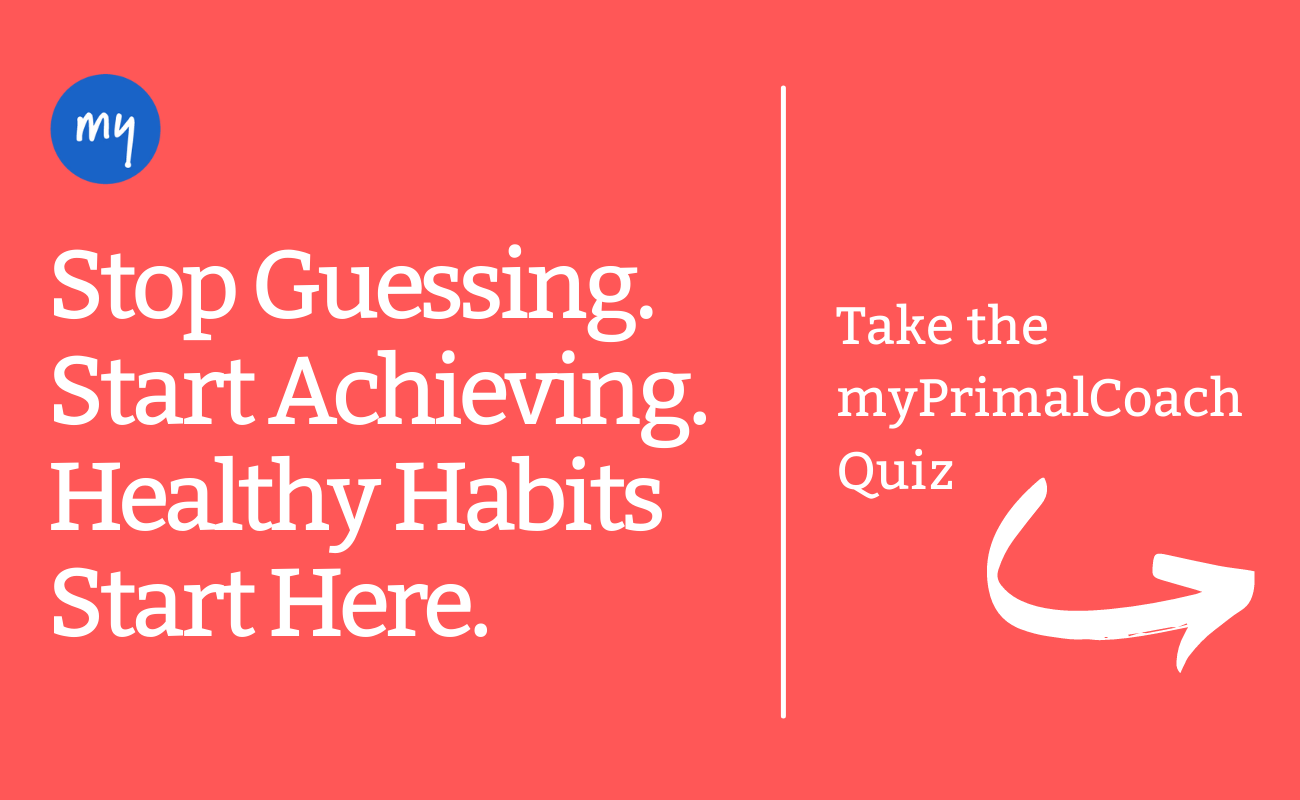Clinician and athletic coach, Dr. Phil Maffetone (founder of the Maffetone Method) took the fitness world by storm when he discovered the three factors that prevent people from reaching their health goals: overtraining, eating processed food, and mental and emotional stress.
What do these three things have in common? Inflammation.
If you’ve worked with our coaches here at myPrimalCoach, you know that chronic inflammation is one of the leading causes of disease. Everything from arthritis and asthma to diabetes, high blood pressure, and cancer.
Long before it was popular to go low carb and meditate, Dr. Maffetone was coaching elite athletes and celebrities on this exact methodology. With one important distinction. He also adjusted the way they exercised. With the Maffetone or MAF Method, you stay exclusively in the aerobic zone.

So, What is the Maffetone (MAF) Method?
MAF stands for maximum aerobic function. It’s a method of lower-intensity exercise that trains your aerobic (aka fat-burning) system to become more efficient. It controls chronic inflammation, plus improves your fitness level, helps you recover from workouts faster, burns more fat, and reduces your risk of injuries. With the MAF Method, you train at a slower pace and reap bigger rewards.
But how do you know how slow to go? Maffetone says it all has to do with heart rate. By calculating your max aerobic heart rate (which we’ll dive into here in a second), you tap into the sweet spot for optimal health.
Aerobic Exercise
Maffetone’s thinking is based on work by exercise physiologist, Dr. Kenneth H. Cooper. In the late 1960s, Dr. Cooper coined the term “aerobic” to describe a method of exercise he formulated for astronauts to condition their cardiovascular systems. But soon he (and Maffetone) discovered it could be useful for the general public as well.
Aerobic means “with air” or “with oxygen.” Basically, when you’re engaged in aerobic exercise, your body uses oxygen to produce energy for sustained activity. Your heart gets conditioned, your muscles benefit from more blood flow, and you get into a desirable fat-burning zone. Not only that, aerobic exercise can actually prevent inflammation.
Forms of aerobic exercise include:
- Running
- Swimming
- Cycling
- Rowing
- Hiking
Anaerobic Exercise
In contrast, anaerobic refers to “without air.” Anaerobic exercise involves faster, higher intensity moves that use the glucose stored in your muscles for energy. Your lungs can’t push enough oxygen into the bloodstream to fuel your workout. So, your body temporarily stops burning fat for energy and starts burning glycogen (aka sugar).
Forms of anaerobic exercise include:
- HITT training
- Sprinting
- Heavy weightlifting
- Plyometrics
- Chronic higher-intensity cardio
Anaerobic activities definitely have benefits, but they’re harder on the body and tend to increase inflammation. Plus, it trains your body to prefer burning carbs for energy and keeps your sugar-burning genes active for up to 72 hours post-exercise. Combine that with a diet high in processed carbs and a stressful lifestyle, and you could be stuck in a vicious cycle of inflammation.
How to Calculate your Maximum Aerobic Heart Rate
Start by subtracting your age from 180. That’s the maximum number of beats per minute (BPM) you should aim for while exercising. So, if you’re 40 years old, you’ll subtract 40 from 180 to give you 140; if you’re 50 years old, subtract 50 from 180; if you’re 30 years old, subtract 30 from 180. You get the idea.
Your heart rate must remain below the 180-age equation to stay in that critical fat-burning zone. For those of you who’ve never trained with a heart rate monitor before, this pace will likely feel way too easy, but that doesn’t mean it’s not working. In fact, quite the opposite. This is where the magic happens. With MAF training, you’ll start to see an improvement in your fitness level, you’ll quickly build your base if you’re training for endurance, and you’ll make more fat-burning mitochondria.
Even if you don’t mind going harder, don’t be tempted to push past your aerobic max or you’ll negate the benefits. To keep your heart rate low during exercise, you might need to take a walk break, pause in between laps, or lift lighter weights.
The 180 minutes your age equation is where you’ll start. If you have a recent injury, health condition, or are just getting into fitness, there are additional calculations to consider:
- Subtract an additional 10 BPM if you’re on medication, recovering from a hospital stay, rehabbing, or dealing with overtraining syndrome
- Subtract an additional 5 BPM if you’re injured, get sick more than twice a year, have seasonal allergies or asthma, or are getting into (or back into) working out
- Add 5 BPM back in if you’ve been training for more than two years without any issues listed above and are improving consistently.
Additional modifications can be made for those 65 and up and 16 and under. Your health coach can see what adjustments you should make to your maximum heart rate.
How Effective is MAF Training?
Imagine getting faster, having fewer injuries, and enjoying your workout instead of dreading it. With MAF training, it’s all possible, and more. Some benefits, like fat loss, are noticeable. Others are more subtle, yet just as impactful. For instance, you’ll have:
- Steadier energy throughout the day. Because your body gets better at using the fat you eat and store, there’s always fuel available to burn.
- Better functioning mitochondria. Mitochondrial dysfunction is at the root of many diseases. When your mitochondria work better, you feel better, have more mental focus, and sustain higher activity levels without fatigue.
- More mitochondria. The more mitochondria you have, the better you are at burning fat.
- You may even live longer. Research shows that lower-intensity exercise protects against early mortality compared to regular high-intensity training.
Maffetone’s approach is scientifically proven too. In this study, one group of 223 male and female runners were assigned training heart rates just below their maximum aerobic threshold. They were told to maintain their previously weekly mileage at their assigned heart rate. Out of the group, up to 81.9% of the runners improved their 5k race times.
Track Progress with the MAF Test
Want to improve your time? You’ve got to establish a baseline first. That’s where the MAF test comes in. To perform the test, start with your maximum aerobic heart rate (that’s the 180 minus age calculation we mentioned). You can walk, bike, swim, or jog — that part is up to you. The goal of the MAF test is to determine the time it takes to cover a certain distance. There’s no wrong answer here. This is just your baseline.
Maffetone recommends repeating the test once a month to review your progress. If you’re headed in the right direction (i.e., staying in the fat-burning zone), you’ll be able to cover more distance in the same amount of time. If you’re going in the wrong direction, you’ll see no improvement or may even cover less distance.
Here’s how to do the MAF test:
- Select a course or distance that you’ll use every time you do the MAF test
- Warm up for 10 to 15 minutes, keeping your heart rate 10 beats below your max aerobic heart rate
- After the warm up, run, walk, swim, or bike as close to your target heart rate as you can for the entire test
- Complete the test at the same time of day the next time you do it
- Note your results so you can compare them with subsequent tests
Who Can Benefit from the MAF Method?
The MAF Method is popular with runners, but anyone who wants to reduce inflammation and become a more efficient fat-burner can benefit from this approach. It’s also for those who want to:
- Improve their aerobic base
- Learn to focus on effort versus pace
- Prevent injuries
- Help reduce sugar cravings
- Recover from workouts faster
Get Fit Using a Heart Rate Monitor
A heart rate monitor lets you track your heart rate in real time (if you have a Fitbit or Apple Watch, you already own one). Wrist-based monitors, like Fitbits, use an optical sensor that takes a reading from the blood vessels under your skin. Wearing them a little tighter than usual will help you get a more accurate reading.
Chest straps are another option for monitoring heart rate. Paired with a smartphone or watch, a chest strap uses the heart’s electrical signals to measure BPM. While it is highly accurate, it needs to be worn under your workout clothes so that it lays right on top of the skin.
The last option is an ear monitor. Like wrist-based monitors, ear monitors use optical sensors but tend to be more accurate and more comfortable to wear. The ear’s blood vessels are close to the skin’s surface, so it’s easy to get a good reading. Plus, these devices are often built into headphones, so monitoring your heart rate is as simple as listening to your favorite playlist.
Summary
The Maffetone Method is a three-pronged approach that trains your body to become more efficient at using energy. Through diet, stress management, and staying below your maximum aerobic threshold, you amp up mitochondria production and reduce inflammation. You’ll also benefit from everything from increased performance to fat loss, fewer injuries, and more enjoyable workouts.
The point isn’t to see how fast you can go, it’s to change how your body gets energy. Which means going slower than you think you should. Remember the 180 minus your age formula. And factor in any medications, allergies, and recovering from overtraining syndrome, which subtracts additional beats per minute.
Whether you’re new to working out or a seasoned athlete, knowing how your heart rate affects your body on a holistic level allows you to train much more effectively.

